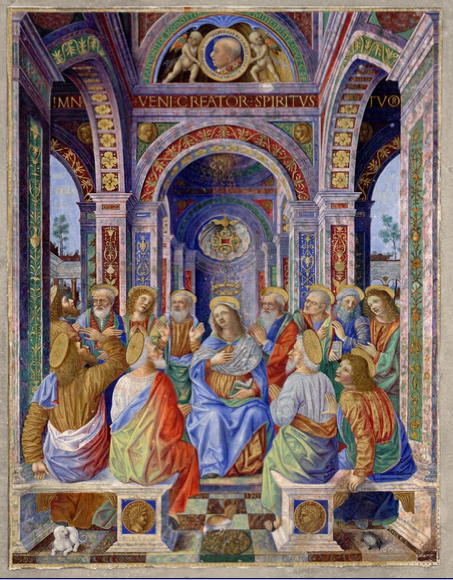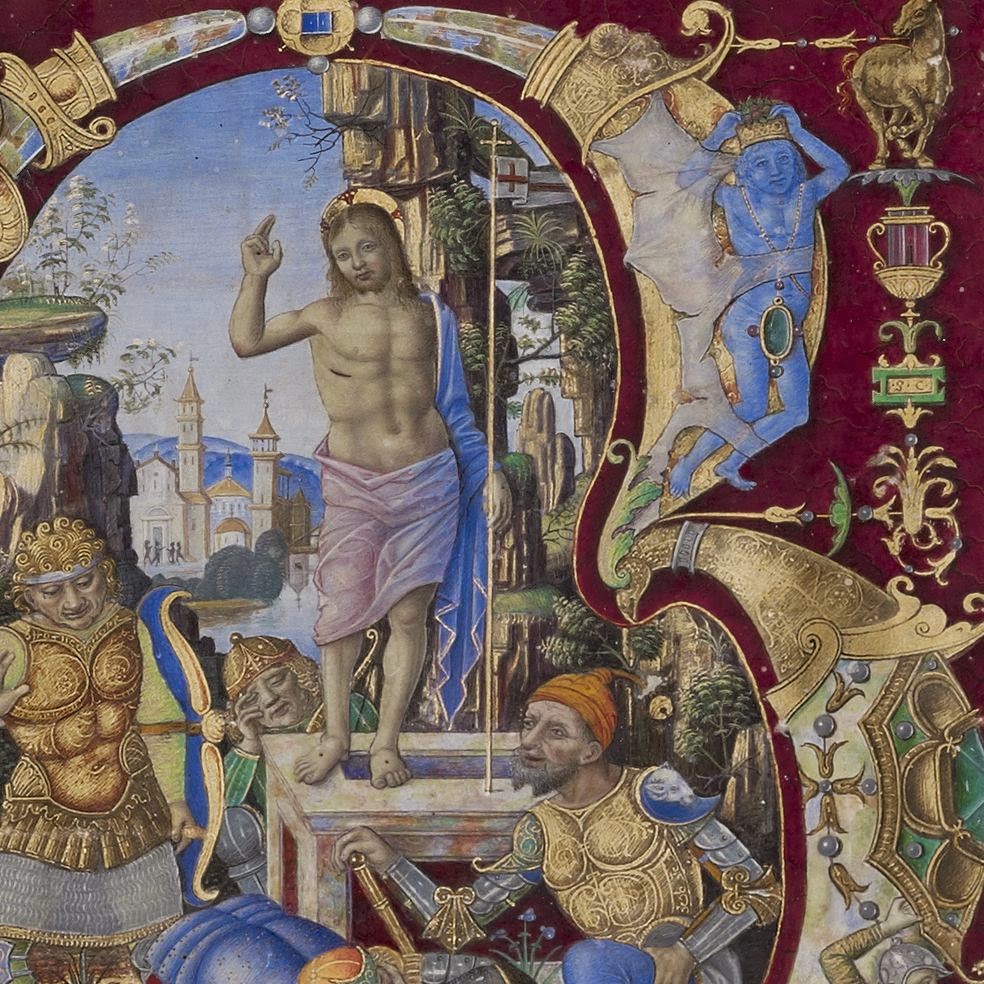Fra Antonio da Monza (active 1492/1503 )
Pentecost
1492 - 1503
Miniature on Parchment
33,5 x 27,7 cm
Albertina Museum, Vienna, Austria
Pope Pius XI (Ambrogio Damiano Achille Ratti) (31 May 1857 – 10 February 1939), was Pope from 6 February 1922 to his death in 1939.
Before he became a diplomat, he was a scholar of no mean repute
He was at the Ambrosian Library (the Biblioteca Ambrosiana) in Milan, from 1888 to 1911. He was made Prefect in 1907
In 1911, at Pope Pius X's invitation, he moved to the Vatican to become Vice-Prefect of the Vatican Library, and in 1914 was promoted to Prefect.
While in Milan, he transcribed and published codices and rare archival documents. He reordered the Library of the Certosa di Pavia, the Library and the Pinacoteca Ambrosiana,as well as the Museo Settala
He recovered and restored the codices and manuscripts of the Chapter of Milan Cathedral which had been damaged by fire
As Pope he founded the new Vatican Pinacoteca, in a special building near the new entrance to the Museums. He also founded the Missionary-Ethnological Museum in 1926, arranged on the upper floors of the Lateran Palace before it was moved elsewhere
Occasionally one comes across articles and works from his early period in Milan
There was an interesting debate in which he took part concerning the Lombard miniaturist and Franciscan Fra Antonio da Monza (active about 1480 - 1505)
His Pentecost (above) is now in the Albertina
It was for a Festmissale for the then Pope Alexander VI, the Borgia Pope whose features also adorn the work. The choir books were a gift by the Pope for Santa Maria in Aracoeli and the Observant Franciscans within the Church
Fra Antonio appears to have been a member of the Observant Franciscans
Fra Antonio appears to have been a member of the Observant Franciscans
Antonio's artistic style was influenced by the art of Leonardo da Vinci. Scholars have attributed several liturgical books, as well as some miniatures in the Sforza Hours and in Antonio Minuti's Life of Muzio Attendolo Sforza, to him. Minuti was a notary and chancellor to the Sforza family
Here are some works where positive attributions to him have been made
The work and identity of Fra Antonio da Monza was only revived by researchers in the late nineteenth century, but little is known about his life or career
He is a mysterious figure
Art historians have attempted to piece together the oeuvre of Fra Antonio da Monza or cited individual works as successful examples of hybrid compositions
One of these historians was the great German art historian Paul Kristeller (1863 - 1931) not to be confused with the great Columbia University scholar of the Italian renaissance, Paul Oskar Kristeller (1905-1999). {But of course they often are and the works of the earlier are often shown as works of the latter)
He poured cold water on the idea, demolished the reasons given for the attribution and clinically advanced reasons why on the basis of the existing evidence Fra Antonio could not have been the engraver
Why the bother ?
Possibly a number of reasons can be envisaged
He wanted the truth to come out and be established according to the hard facts and evidence and be established in a positive rational way and not on the basis of pure subjective opinion and reverie
The thesis which he attacked ignored the possibility or even probability that around 1500 there was in his beloved Milan, his beloved Lombardy a mature and thriving market for art filled with mature and sophisticated artists and their customers
For Kristeller was firmly of the view that the peak of Italian woodcut was to be found in Venice and Florence and that outwith Rome and Naples there were no local schools of woodcut in Italy
Of course he also wished to guard the academic reputation of the highly regarded Biblioteca Ambrosiana
Here is his article with the illustrations:
Antonio da Monza (active about 1480 - 1505)
Initial R: The Resurrection
From Introit for Easter, Gradual: Ms. Ludwig VI 3 (the Ludwig Aracoeli Manuscript,)
late 15th or early 16th century
Tempera colours, gold leaf, and ink on parchment bound between original wood boards covered with brown leather
64.1 x 43.5 cm (25 1/4 x 17 1/8 in.)
The J. Paul Getty Museum, Los Angeles
Antonio da Monza (active about 1480 - 1505)
The Crucifixion
c. 1492 - 4
From The Christmas Missal of Pope Alexander VI Ms. Borg. Lat. 425, folio
38v
Missa in Nativitate Domini Nostri Iesu Christi, hora tertiarum Pontifice Maximo celebrante
Gouache, ink, and gold on vellum,
46.5 x 32.4 cm
Biblioteca Apostolica Vaticana. Vatican
He is a mysterious figure
Art historians have attempted to piece together the oeuvre of Fra Antonio da Monza or cited individual works as successful examples of hybrid compositions
One of these historians was the great German art historian Paul Kristeller (1863 - 1931) not to be confused with the great Columbia University scholar of the Italian renaissance, Paul Oskar Kristeller (1905-1999). {But of course they often are and the works of the earlier are often shown as works of the latter)
Kristeller as one of the leading art historians of the Italian Renaissance became interested in Fra Antonio
In 1901 he published a monograph Fra Antonio da Monza, incisore in Rassegna d'arte I (1901), pp 161-164 and wondered whether on the basis of two hitherto unattributed prints he discovered in Milan whether Fra Antonio had also been an engraver and printer
The evidence he adduced was slight and unconvincing but his view was taken up by some art establishment figures such as S. Arthur Strong, Librarian to the House of Lords and at Chatsworth, Sir Sidney Colvin (Keeper of the Department of Prints and Drawings at the British Museum) and Arthur Mayger Hind (later Keeper of the Department of Prints, British Museum)
They also prayed in aid the views of the Biblioteca Ambrosiana and Monsignor Ratti
This seems to have been the final straw
In 1912 Monsignor Ratti published his counterblast: Achille Ratti: A. Frate da Monza incisore? - Contributo alla storia delle arti grafiche milanesi . In: Rassegna d'arte XII (1912), pp 133-139
He poured cold water on the idea, demolished the reasons given for the attribution and clinically advanced reasons why on the basis of the existing evidence Fra Antonio could not have been the engraver
Why the bother ?
Possibly a number of reasons can be envisaged
He wanted the truth to come out and be established according to the hard facts and evidence and be established in a positive rational way and not on the basis of pure subjective opinion and reverie
The thesis which he attacked ignored the possibility or even probability that around 1500 there was in his beloved Milan, his beloved Lombardy a mature and thriving market for art filled with mature and sophisticated artists and their customers
For Kristeller was firmly of the view that the peak of Italian woodcut was to be found in Venice and Florence and that outwith Rome and Naples there were no local schools of woodcut in Italy
Of course he also wished to guard the academic reputation of the highly regarded Biblioteca Ambrosiana
Here is his article with the illustrations:
A work of great erudition and scholarship but both are lightly worn by the very learned author
This was written before the time when academics had research assistants and students who did first or second drafts
One notes the pointed ending with the Classical allusion
The reply came from Kristeller in his Die Lombardische Graphik der Renaissance. Berlin: Bruno Cassirer, 1913. - in a large passage and a footnote:
The First World War put an end to the debate
However in the 1940s and beyond Father Ratti`s view held sway and Kristeller`s was overruled









.jpg)
.jpg)
.jpg)
.jpg)
.jpg)
.jpg)
.jpg)
.jpg)




















